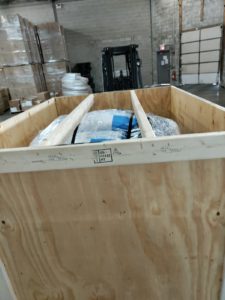Most artists and collectors are confused when preparing their works of art for travel and the actual transportation procedure, particularly when shipping art, typically speaking statues. There’s no need to worry, though, since we can make this difficult task seem simple.
Moving a statue is distinct from packing and transporting a painting or another comparable work of art. If you package your goods carefully, they will remain secure during shipping. Take necessary precautions to wrap statues for shipping properly since you cannot control how they will be handled or transported throughout the shipping process.
 Preparing for Shipping:
Preparing for Shipping:
People occasionally try to make cross-country moves less difficult by exporting their belongings (We can help there). If you had a large, delicate sculpture, you could send it, and your movers could move the rest of your stuff. To pack as securely as you can, stock up on packing supplies. Grab the following things:
- Paper Shredder
- Packing Peanuts
- Polythene Wrap
- Wooden crates or tape boxes
- Packing Material
Or Let Us do an On-Site Crating Job for you, so you can take comfort in how It’s happening!
Packing Statues of different Shapes for Shipping:
The basic principle is essentially the same for statues in various sizes and forms. Whether you made the statue or purchased it, you should take the time to box it carefully. It cannot simply be wrapped and placed in a box. Pack it tightly to prevent possible damage during shipment because shipping occasionally involves various modes of transportation and handling. Make sure you pack some extra to transport statues for their protection. To save on overpaying, see whether your movers already have the packing supplies you require.
Packaging Method:
Each statue is unique and will have a different set of requirements to ensure safe arrival. It is why it’s crucial to evaluate each company’s packing and shipping procedures individually; what works for a large marble sculpture won’t necessarily work for a wooden carving or welded metal object and we understand that vividly.
When packing a statue, you must consider three things:
Keeping it Upright:
Although shipping sculptures in an upright posture might be challenging owing to their height, doing so is the safest course of action.
Protection against Shaking:
Transporting a sculpture for a long distance in the back of a truck can be taxing, and vibrations are frequently inevitable there. The best defense against shaking is sufficient cushioning, although a vehicle with air-riding suspension delivers a smoother ride.
Protection against Impacts like Drops or Bumps:
Due to their weight, sculptures are more prone to be knocked over or dropped during loading and unloading.
When transporting sculptures, crating is a popular procedure and is generally regarded as the most reliable packing technique. Although it may not be essential for small statues, professional movers will frequently secure your sculpture in a vertical position on a pallet before building a container around it. Whatever the construction, foam-padded containers are the best choice for protecting the statue from jolting and damage while in transit.
It is nearly usually advised that you have statues packed professionally due to their size, form, weight, and fragility. You might be able to transport your sculptures if they are tiny, robust, or have little sentimental or financial worth.
Plastic Wrapping:
The best option for covering the sculpture is bubble plastic wrap. It is preferable to wrap individual pieces of a sculpture when packing large or unusually shaped sculptures. It involves wrapping the sculpture’s top, middle, and bottom. Make sure there are no exposed surfaces. In the end, you can add one additional layer of plastic wrap. Use artist tape to hold each layer in place. Don’t tape the sculpture directly. When you unwrap it, tape remnants could hurt the surface. Only the ends of the plastic wrap should ever be taped. If your statue is made of wood, you might want to wrap it in plastic wrap first, then cover it with paper or moving pads. Plastic may lose heat during transportation, harming a hardwood surface. The same applies when you pack wooden furniture.
Packing Peanuts:
Packing peanuts are an excellent alternative to fill the void within your container, but using them alone is insufficient. Small peanuts can move around a lot during shipping and leave space, which increases the risk that your sculpture will run into the package’s side and break or be damaged. Use a combination of packing peanuts and shredded paper to prevent movement in the box.
Using the double box for extra safety:
Artists usually use double boxes for extra protection of their items. Utilize each procedure as if you were shipping it in that specific package. Put the box in the wooden container after you’ve secured it. Then, use blankets, packing peanuts, or shredded paper to fill the space between the crate and the box. Put an arrow and a fragile notice on the side of the carton to identify it.
Labeling the wooden carton or box:
When they wish to be cautious, artists may employ this technique. It refers to placing your statue inside the carton. Use every step as though you were shipping it in that particular package. Place the box in the wooden container once it has been secured. Then use blankets, packaging peanuts, shredded paper, or whatever else you like to fill the space between the crate and the box. Put a fragile notice and an arrow on the side of the carton to identify it.
 Which is better: Boxes or wooden crates?
Which is better: Boxes or wooden crates?
You can select between a box or a wooden crate, depending on the size of your statue. For tiny or medium-sized sculptures, moving crates are an excellent solution. Moving boxes are not the same as ordinary retail boxes. Though they are not as robust as moving boxes, you may usually find free boxes from your neighborhood shop or supermarket. Because they are made to withstand travel without disintegrating, moving cartons are more durable. Moving boxes come in a range of sizes and styles. Whenever possible, use a carton a few inches larger than your sculpture. You won’t be able to put shredded paper into a box that fits the statue perfectly. It must also have sufficient space to wrap and cover the empty area with extra packing materials.
A much bigger box, however, needs a lot of padding material between its edges and your statue. It is not the ideal approach because it involves using more packing materials and allowing for more movement during shipment. For larger and heavier sculptures, wooden boxes are a great option. You may either buy or create the crate. A solid wood floor should not have any gaps between the boards. Before putting your sculpture into a wooden box, fill it with packing peanuts and shredded paper if you’re using one.
Conclusion:
Parcel shipping is the best choice for shipping a single tiny statue or a speedy shipment. Consolidated freight is perfect for frequent or volume shipping, long-distance relocation of artworks, or huge collections. Custom Crating and Logistics can assist; our knowledgeable logistics coordinators can put you in touch with a reputable artwork shipping business and work with you to develop a shipping strategy that fits your schedule, budget, and recurrent shipments.






